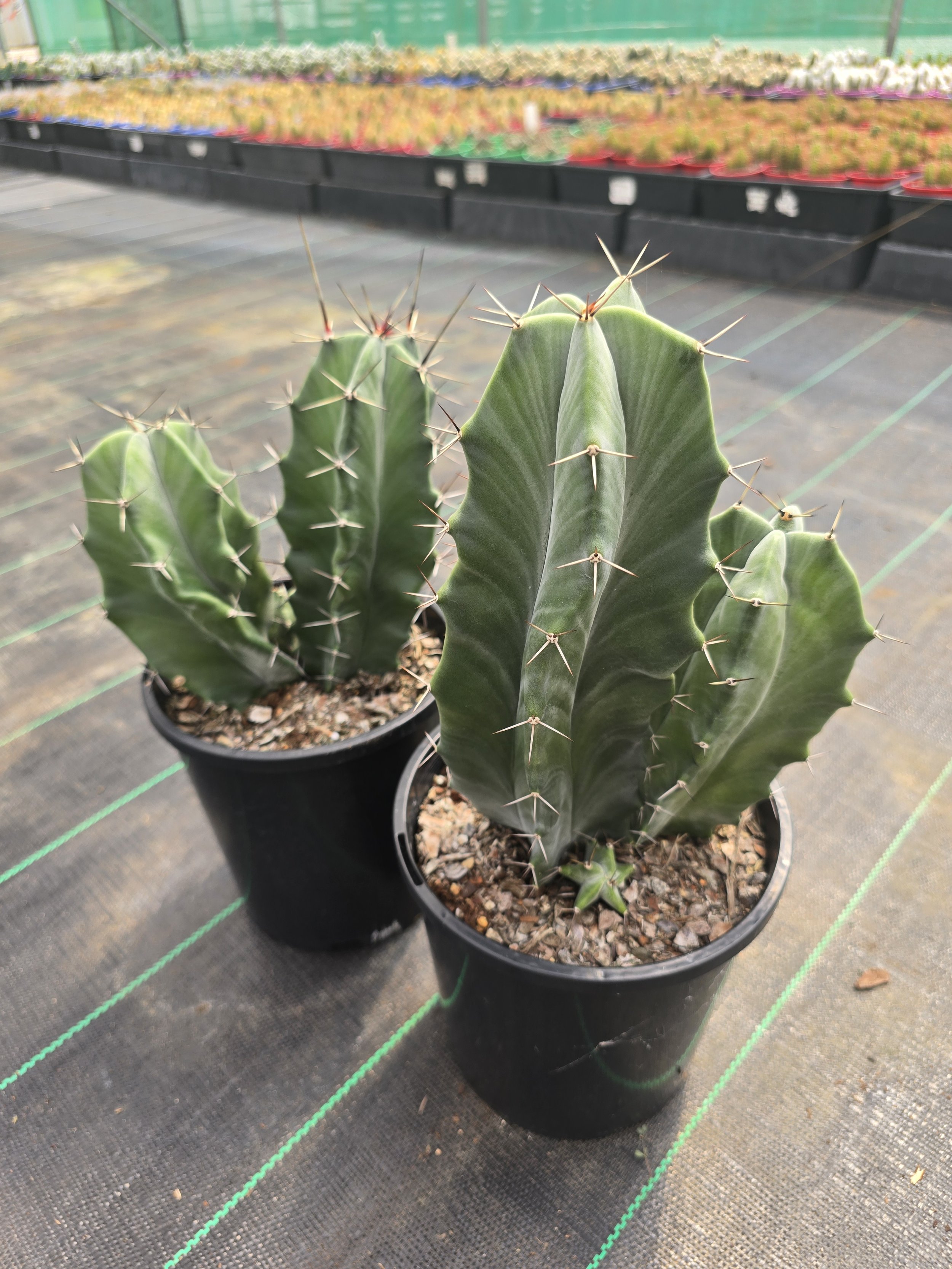 Image 1 of 1
Image 1 of 1


Cereus pruinosus
Stenocereus pruinosus, formerly known as Cereus pruinosus, is a striking columnar cactus native to central and southern Mexico, particularly in the states of Veracruz, Puebla, Oaxaca, Chiapas, San Luis Potosí, Guerrero, and Tamaulipas. It thrives at elevations between 800 and 1,900 meters and is renowned for its edible fruit and ornamental appeal.
🌵 Botanical Overview
Common Names: Gray Ghost Organ Pipe, Pitayo, Pitaya de Octubre, Xoconostle
Family: Cactaceae
Growth Habit: Tree-like or shrubby cactus, typically reaching 4–5 meters (13–16 feet) in height, occasionally up to 7 meters. It often develops a distinct central trunk with V-shaped branching stems.
Stem Characteristics: Dark green to glaucous (bluish-gray) stems, 8–12 cm in diameter, featuring 5 to 8 wavy ribs.
Spines: Areoles bear 3–9 grayish central spines (2–3 cm long, occasionally up to 5 cm) and 5–9 radial spines, usually under 15 mm. de.wikipedia.org+7llifle.com+7llifle.com+7worldofsucculents.com+3llifle.com+3llifle.com+3en.wikipedia.org+1es.wikipedia.org+1
🌸 Flowers & Fruit
Flowers: Funnel-shaped, white, up to 9 cm long, blooming near the stem tips. They open at night and remain open into the next day.
Fruit: Elongated, green to red-tinged, measuring 6–12 cm in length and 5.5–8.1 cm in diameter. The flesh varies in color—yellow, orange, red, or purple—and is edible. en.wikipedia.org+1de.wikipedia.org+1
🌱 Cultivation & Care
Light: Prefers full sun; ensure ample sunlight for optimal growth.
Soil: Requires well-draining soil; a mix of potting soil, sand, and perlite in equal parts is effective.
Watering: Water sparingly, allowing the soil to dry completely between waterings. Reduce watering during cooler months.
Temperature: Tolerant of hot, arid conditions; suitable for USDA zones 9b–12.
Propagation: Can be propagated from stem cuttings or seeds.naturalhistoryonthenet.complantophiles.comgrowplants.org
🌍 Ecological & Cultural Significance
In its native habitat, Stenocereus pruinosus plays a vital role in the ecosystem. Its fruits are a food source for various animals, and the plant itself is used in traditional Mexican cuisine, particularly in the preparation of beverages and desserts.
Stenocereus pruinosus, formerly known as Cereus pruinosus, is a striking columnar cactus native to central and southern Mexico, particularly in the states of Veracruz, Puebla, Oaxaca, Chiapas, San Luis Potosí, Guerrero, and Tamaulipas. It thrives at elevations between 800 and 1,900 meters and is renowned for its edible fruit and ornamental appeal.
🌵 Botanical Overview
Common Names: Gray Ghost Organ Pipe, Pitayo, Pitaya de Octubre, Xoconostle
Family: Cactaceae
Growth Habit: Tree-like or shrubby cactus, typically reaching 4–5 meters (13–16 feet) in height, occasionally up to 7 meters. It often develops a distinct central trunk with V-shaped branching stems.
Stem Characteristics: Dark green to glaucous (bluish-gray) stems, 8–12 cm in diameter, featuring 5 to 8 wavy ribs.
Spines: Areoles bear 3–9 grayish central spines (2–3 cm long, occasionally up to 5 cm) and 5–9 radial spines, usually under 15 mm. de.wikipedia.org+7llifle.com+7llifle.com+7worldofsucculents.com+3llifle.com+3llifle.com+3en.wikipedia.org+1es.wikipedia.org+1
🌸 Flowers & Fruit
Flowers: Funnel-shaped, white, up to 9 cm long, blooming near the stem tips. They open at night and remain open into the next day.
Fruit: Elongated, green to red-tinged, measuring 6–12 cm in length and 5.5–8.1 cm in diameter. The flesh varies in color—yellow, orange, red, or purple—and is edible. en.wikipedia.org+1de.wikipedia.org+1
🌱 Cultivation & Care
Light: Prefers full sun; ensure ample sunlight for optimal growth.
Soil: Requires well-draining soil; a mix of potting soil, sand, and perlite in equal parts is effective.
Watering: Water sparingly, allowing the soil to dry completely between waterings. Reduce watering during cooler months.
Temperature: Tolerant of hot, arid conditions; suitable for USDA zones 9b–12.
Propagation: Can be propagated from stem cuttings or seeds.naturalhistoryonthenet.complantophiles.comgrowplants.org
🌍 Ecological & Cultural Significance
In its native habitat, Stenocereus pruinosus plays a vital role in the ecosystem. Its fruits are a food source for various animals, and the plant itself is used in traditional Mexican cuisine, particularly in the preparation of beverages and desserts.